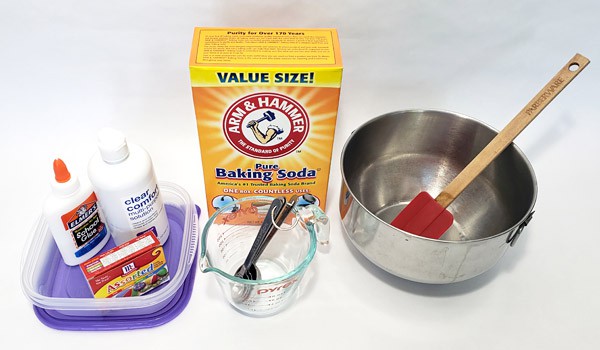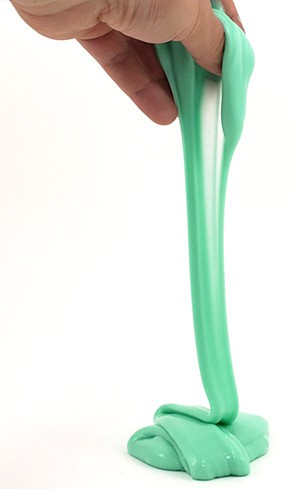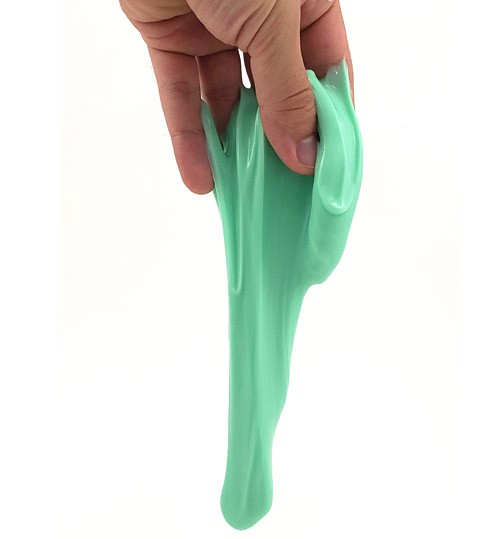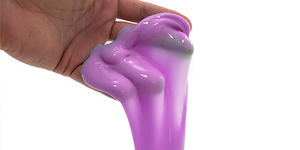Summary
Thanks to the members of the Science Education Council at PPG Industries, for testing, feedback, and advice on this science activity. Read more about how PPG's scientists partner with Science Buddies to make great activities.
Introduction
It's gooey. It's sticky. It's slime! Learn to make your own homemade slime with this quick and easy recipe.
Materials
- Washable PVA school glue (like Elmer's®)
- Water
- Baking soda
- Contact lens solution (must contain both boric acid and sodium borate in ingredients)
- Food coloring (optional)
- Measuring spoons
- Measuring cup
- Mixing bowl
- Spatula
- Resealable plastic bags or food storage containers
-
 Image Credit: Ben Finio, Science Buddies / Science Buddies
Image Credit: Ben Finio, Science Buddies / Science Buddies
Prep Work
Instructions
- In the mixing bowl, thoroughly mix 1/2 C water, 1/2 C glue, and a few drops of food coloring.
- Add 1/2 tsp baking soda and mix completely.
- Add 2 tbsp contact lens solution and stir vigorously until the mixture starts pulling away from the edges of the bowl.How does the thickness of the slime change as you stir?
- Use your hands to knead the slime for 5–10 minutes until its texture stops changing. Do not worry if the slime is very runny and sticks to your hands at first. It will get easier to peel the slime off your hands as it gets thicker.How does the texture of the slime change as you knead it?
- Have fun playing with your slime!What happens when you stretch your slime? Squish it? Roll it into a ball and bounce it?
 Image Credit: Ben Finio, Science Buddies / Science Buddies
Image Credit: Ben Finio, Science Buddies / Science Buddies
Cleanup
- Store your slime in an airtight container to prevent it from drying out. Dispose of any excess bits of slime in the trash—do not pour them down the drain, or they could cause a clog.
What Happened?
Glue is very runny. When you mix contact solution with glue, a chemical reaction occurs that causes the glue to get thicker. This reaction takes some time, which is why you have to stir and knead the slime. Eventually the slime will become rubbery and stretchy instead of "liquidy." Read the Digging Deeper section to learn more.
Digging Deeper
Glue is made from long, skinny, chain-like molecules called polymers. These molecules can slip and slide around each other, kind of like the noodles in a big pot of fresh-cooked spaghetti. That is why the glue is very runny and can flow easily when you squeeze it out of the bottle. When you mix a chemical called borax with the glue, it causes links to form between the polymer chains. This process is called crosslinking. Once crosslinks form, it becomes harder for the polymers to slide over each other, making the glue thicker and creating "slime."
In this project, you used contact lens solution instead of borax as one of the ingredients. Contact lens solution contains other chemicals called boric acid and sodium borate. When mixed with baking soda, these chemicals react and produce borax.
Ask an Expert
For Further Exploration
- There are many different variations of the basic slime recipe. Try adding one of the following ingredients to change the properties of your slime:
- Glitter to make sparkly slime
- Iron filings to make magnetic slime
- Glow-in-the-dark paint to make glow-in-the-dark slime
- Thermochromic pigment to make color-changing slime
- Tonic water to make glow-in-black-light slime
- Try changing the amount of one ingredient in your slime recipe, for example, by using more or less contact lens solution. How do the properties of the resulting slime change?
- To make "fluffy" slime, use 3 cups of foam shaving cream instead of water in your recipe.
Disclaimer: Science Buddies participates in affiliate programs with Home Science Tools, Amazon.com, Carolina Biological, and Jameco Electronics. Proceeds from the affiliate programs help support Science Buddies, a 501(c)(3) public charity, and keep our resources free for everyone. Our top priority is student learning. If you have any comments (positive or negative) related to purchases you've made for science projects from recommendations on our site, please let us know. Write to us at scibuddy@sciencebuddies.org.










